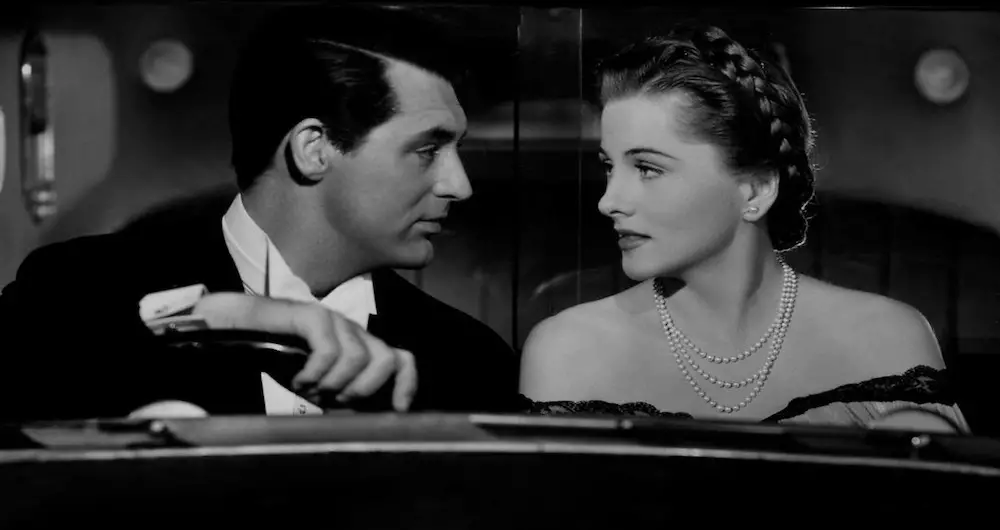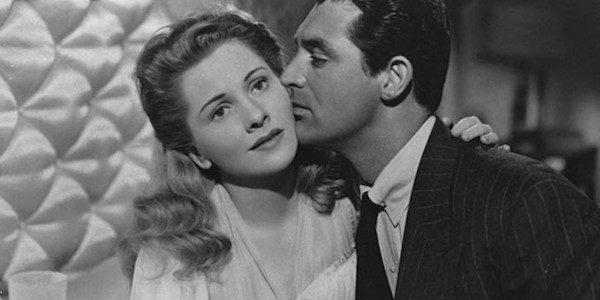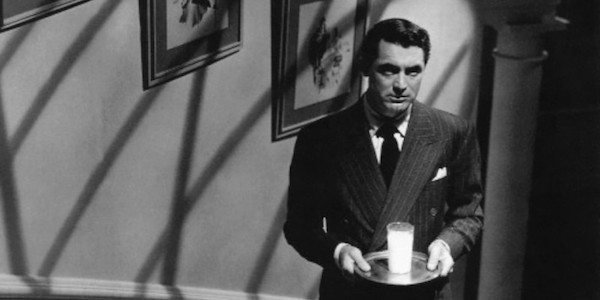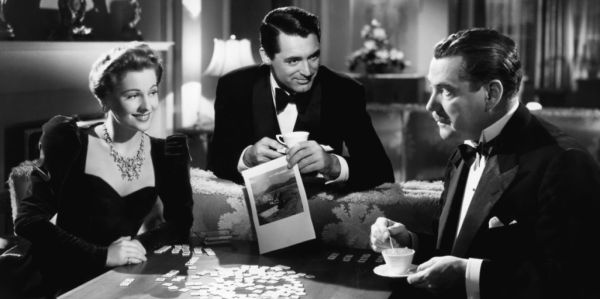The Nominated Film You May Have Missed: SUSPICION

Stephanie Archer is 39 year old film fanatic living in…
Every year, ten movies are bestowed the honor of becoming nominated by the Academy of Motion Arts and Sciences. Many of these films will have already had various successes throughout the year; good festival attendance, box office success and the receiving of other prestigious awards. Yet, only one of the ten films ends the night being declared the best of the best.
In 1942, there were only five.
Each month, I select a nominated film that, while not receiving the ultimate prize in the end, should be at the top of your must-see list: a film for your reconsideration. Every film nominated by the Academy has something special about it that makes it stand out amongst films from the entire year. Just because they didn’t get the highest recognition, we can’t ignore that there is something ‘must-see’ about them. This month, I bring to you Suspicion by Alfred Hitchc*ck.
Following a year after his film Rebecca won for Best Picture, and almost two decades before Psycho, Alfred Hitchc*ck’s Suspicion was a front-runner for the ultimate prize. From a great story to remarkable character development and everything in between, this movie is not only a film every Hitchc*ck fan should see, but every moviegoer as well.
Suspicion
Suspicion is a thriller that follows the story of a young couple who get whisked into a marriage that quickly crumbles into suspicion and doubt. Immediately upon returning from their honeymoon, Lina discovers that the man she has married may not be all he seemed to be. While he had radiated the image of wealth, prosperity and success, she learns that he is penniless – his life financed through loans provided by friends. Finding the ability to overlook this, Lina continues on, only to find herself sinking in her suspicion that her husband may be murdering for money – and she is next.

The movie forces you to examine and question what suspicion is – placing judgement the eye of the beholder. How suspicious should we be when first meeting an individual? What is it to be suspicious of one’s own spouse? As viewers, we are accompanying Lina’s on this journey – finding ourselves to be as suspicious of the film as she is her own husband.
Character Development
What makes this film so strong and so special for the times is the in-depth character development that plays out in the beginning and throughout this film. Without it, this movie would have had no legs to stand on. The believability and understanding of the film depends on it.
From the very beginning of the film, Lina, played brilliantly by Joan Fontaine, is the quintessential representation of emotional instability and feeble-mindedness. From the very first scene, we see her unable to defend herself and easily giving into the demands of Johnnie, played by Cary Grant. Bursting into her train compartment uninvited, Johnnie invades her space both physically and in conversation. She remains silent, clearly his invasion unwelcome.
It is learned shortly there after that Johnnie possesses a Third Class Passenger Ticket and must move to the back of the train or pay the difference. While seemingly against his request, Johnnie sees the change he needs in Lina’s hand, as he has none on him, and takes it paying off the ticket. Lina does not fight or protest, turning a blind eye and silently returning to her book.
With this early insight of her character, we are led to believe and understand that Lina is easily taken advantage of and allows those around her to direct how she acts and what reaction she is willing to give in response. This is important to understand and remember as the film continues, and the true nature of the situations around these two individuals comes to light.

Her feebleness is quickly coupled with her emotional instability as the film continues. While originally denying Johnnie a visit later in the day, and holding off his advances, she quickly dives into a relationship – driven by an overheard parental conversation concerning her prospect of becoming a spinster. She is first to kiss Johnnie and finds herself an emotional mess during the following week when she hears not a word from him. Finally, with her romantic feelings confirmed, Lina agrees to an engagement with Johnnie, abandoning her family and eloping the following morning.
Lina shows early on in the film that she is impulsive, emotional and easily disillusioned. As secrets of Johnnie’s life are revealed, her emotional instability begins to give way, allowing her to fall rapidly into suspicion and fear for those closest to Johnnie – as well as for herself. This makes her descent into madness and suspicion all the more believable – resulting in the audience falling with her.
Alongside Lina’s character being complex and well-defined, Johnnie’s character is just as in-depth as hers, though his complexities are revealed in pieces throughout the film. He, like his counterpart, is impulsive – swept up into a marriage before taking the time to get to know Lina. He is also immediately shown to be a smooth talker – obtaining money in the very first scene for an upgraded train ticket along with winning Lena’s heart.
As the film continues, the story builds upon his impulsive personality. He is revealed to be a gambling addict – selling or behaving in any way to obtain the next bet in hopes of living the life he dreams of. His personality and character traits are a strong foundation of this film, as well as important to maintain the pace and believability of the film
Symbolism
There is a valuable use of symbolism within this film, primarily with the framed art work displayed at various moments. Art work is permanent but everlasting. It is a representation that can mean several things at once, and is open to interpretation by the beholder.
Early on in the film, a painted portrait of Lina’s father is introduced. Johnnie and Lina mockingly interact with it, falsely obtaining a blessing for their marriage. Through all the mockery and carelessness, they show the painting disrespect – just as their rapid engagement and subsequent marriage did. Yet, this portrait comes back to haunt them with the passing of Lina’s father
Following her father’s death, Lina is endowed with the painting, a comeuppance for the disrespect they showed her father, and her family. The symbolism is also a parallelism of how their swift leap into marriage without knowing one another has its ramifications as well.

Her father’s portrait continues to make strategic appearances throughout the film, seemingly overlooking and placing judgement through each brush stroke. When Lina learns the news of the death of Johnnie’s long time friend, Beaky, the portrait of her father takes up the background of the shot, looking over her shoulders – his eyes judging her and the predicament that she finds herself in. Her father had said in the beginning of the film that he did not like Johnnie, and his stagnant eyes are a constant reminder.
Though it is not just the portrait of Lena’s father that is symbolic in the film, but also a small modern art portrait that has strong symbolism as well. At this point in the film, our character’s are drowning in a sea of suspicion and doubt when an officer arrives to question the couple. Upon entering the foyer, the officer quietly looks at the picture – studying it. Before leaving the house, he gazes at the portrait again, continuing to quietly take the portrait in.
The small portrait is symbolic of the madness and deterioration of Lina’s state of mind. Her suspicion, her doubt and her fear are simmering, threatening to boil over. The painting appears to depict a broken figure – Lina is broken, unable to save those around her or herself.
Film Techniques & Foreshadowing
For the first half of the film, the scenes are short and transition quickly giving the film a fast pace that parallels the world-wind relationship of our two main characters. As the movie continues, the scenes become longer and more drawn out – adding to the suspense and intensity of the film.
Suspicion, the title itself, is foreshadowing. Viewers know to be cautious, to question everything they see – to be suspicious. Entering into the film, it is foreshadowed that not everything is as it may seem. There are various clues laid out to either remind you to be suspicious, or to further heighten your suspicion.
Scrabble pieces are used, spelling out words such as doubtful and murderer, giving viewers a foreshadowing of a possible direction of the film – as well as continuing to fuel the digression of Lina’s sanity.
Lina, fearful that her husband had committed a crime and returning home after discovering his innocence, arrives home relived. However, as she walks up to her door to enter, a dark shadow casts across the door – foreshadowing the darkness that is coming – both in reality as well as in Lina’s mind.
Conclusion
Through a strong story, amazing character development, and beautiful filming techniques this film is a wonderful classic from this golden age of film and from the legend Alfred Hitchc*ck. Suspicion is an early classic in the plethora of Alfred Hitchc*ck films and is the perfect movie for this Halloween season.
Have You Seen Suspicion? Tell us what you thought in the comments below!
Does content like this matter to you?
Become a Member and support film journalism. Unlock access to all of Film Inquiry`s great articles. Join a community of like-minded readers who are passionate about cinema - get access to our private members Network, give back to independent filmmakers, and more.













